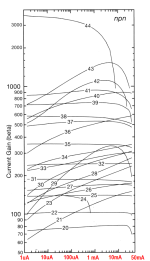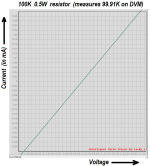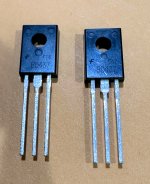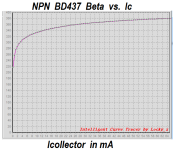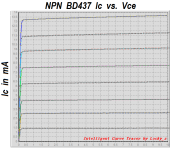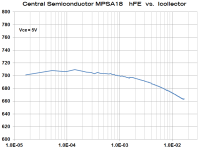No need to test much below 1 mA, beta is not linear, better to avoid.
Example SSM2210 at 25 degrees

Example SSM2210 at 25 degrees
I would also try to test under real life conditions.
My workflow would be: If the idle current is 5 mA, set Ic span to 2 mA - 8 mA, so testing temperature will match conditions in real circuit. Check for best Vce. Choose best transistor for the position. Eventually adjust idle Ic.
My workflow would be: If the idle current is 5 mA, set Ic span to 2 mA - 8 mA, so testing temperature will match conditions in real circuit. Check for best Vce. Choose best transistor for the position. Eventually adjust idle Ic.
No need to test much below 1 mA, beta is not linear,
Quite a few of the NPN transistors tested by Horowitz and Hill, had nice linear beta below (Ic = 1mA). This is their measured data from real devices, not datasheet promises.
Take a quick look at device numbers 25, 27, 32, 35, and 38.
Attachments
Locky-Z curve tracer goes up to 1000 mA and down to sub-100uA. I haven't done a lot of work with it at super low currents so I don't have observations and experience about the level at which measured current values become untrustworthy.
Here's a super quick test to observe its operation below 0.1 mA. I simply connected a 100K resistor to the curve tracer and had it run a Zener diode test (four quadrant current-versus-voltage). The measured data looks quite nice and has about zero integral nonlinearity , zero differential nonlinearity. I think I'm quite comfortable with its measurements down at 0.01mA (ten microamps) and perhaps even down to 0.004mA (four microamps). Take a look:
_
Attachments
Why do the "bad promises" in the datasheets always contradict these measurements in the same way?Take a quick look at device numbers 25, 27, 32, 35, and 38.
I have looked at many datasheets, especially of dual transistors and can not remember anything like that.
Maybe you check some of your examples.
One rare exception seems to be SSM2212
Last edited:
Mark, could you measure a BD140 to 50mA ? For now I am limited to NPN. Later we could compare the results.
When I have time, I will build the PNP version and use AD534 for division.
So it will be possible to match N and P on a 2 channel scope.
So it will be possible to match N and P on a 2 channel scope.
Mostly because the processes have significantly improved since the type # has been filed.Why do the "bad promises" in the datasheets always contradict these measurements in the same way?
Transistors like 2N2222 have been through a number of generations, mainly aimed at reducing the cost (=chip area), but also the improvement of certain characteristics linked to the cleanliness of the process, leakages and low-current beta for example.
This can be seen in the breakdown behaviour of modern transistors vs. their ancestors: practically all older types exhibited a "snap" behaviour (negative resistance) when tested for Vceo or Veco.
This has mostly disappeared with modern versions, because the difference between Vceo and Vces is heavily related to surface currents, contamination.
Nowadays, even cheap generic Chinese types behave quite decently at a nA Ic level.
The datasheets have generally not been updated, because the changes are improvements, and new devices pass the old tests with flying colors
So I wonder why for the SSM2210 hfe linearity down to µA is not claimed in the datasheet as it is for the SSM2212.
This is no old transistor.
This is no old transistor.
Best I could do in TO-126 is the Fairchild BD437. Datasheet attached, along with curve tracer results from 20 minutes ago.
_
_
Attachments
Last edited:
Thanks, I was specially interested in the BD140, also because datasheets differ between manufacturers.
I have tested 4 Motorola SDA-11 dual transistors.
All match well left to right, but first one in upper picture looks very different from the rest.


All match well left to right, but first one in upper picture looks very different from the rest.
I added a 200 ohms pot on the emitter of the dut.
It is nice to see the changes in real time, makes it easy to adjust.
Probably not a good idea to blindly just add "some emitter degeneration".
MAT01 with and without degeneration:
Note:
I always adjust gain on the scope so that the shape of the trace is clearly visible.
So it does not necessarily mean the transistor has bad linearity.


It is nice to see the changes in real time, makes it easy to adjust.
Probably not a good idea to blindly just add "some emitter degeneration".
MAT01 with and without degeneration:
Note:
I always adjust gain on the scope so that the shape of the trace is clearly visible.
So it does not necessarily mean the transistor has bad linearity.
Last edited:
CDC1510249-00 I think from Tektronix from 1968
With 10x sensitivity the top becomes clearly visible at 8,5 mA


With 10x sensitivity the top becomes clearly visible at 8,5 mA
One of my favorite high-Beta NPN transistors, the Motorola MPSA18, has been discontinued by Fairchild, OnSemi, Phillips, and ST. Which is a shame, I think it's a wonderful device.
However, I've discovered that "Central Semiconductor" of Happague, New York now makes and sells the part. So I bought a few from the Mouser sales page (their part# 610-MPSA18) and tried them out. I'm pleased with the results I've seen this far. Yaay!
Better yet, I realized that although LockyZ's software won't make a log plot, Microsoft Excel will. So here's the data, measured less than 30 minutes ago, from a Central MPSA18. It's nice.
_
However, I've discovered that "Central Semiconductor" of Happague, New York now makes and sells the part. So I bought a few from the Mouser sales page (their part# 610-MPSA18) and tried them out. I'm pleased with the results I've seen this far. Yaay!
Better yet, I realized that although LockyZ's software won't make a log plot, Microsoft Excel will. So here's the data, measured less than 30 minutes ago, from a Central MPSA18. It's nice.
_
Attachments
I don't want to derail things...
Anybody here with any experience with or thoughts about this product?
Electron Plus CTL-503
On the surface, it seems like a decent candidate for a computer connected device.
Anybody here with any experience with or thoughts about this product?
Electron Plus CTL-503
On the surface, it seems like a decent candidate for a computer connected device.
- Home
- Design & Build
- Equipment & Tools
- Transistor HFE - IC curve tracer?
